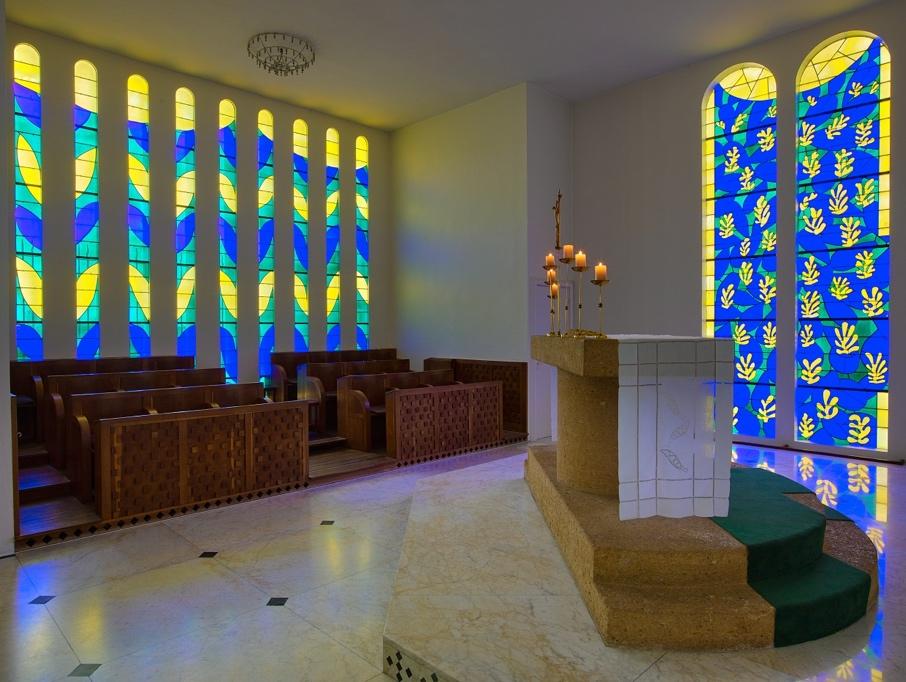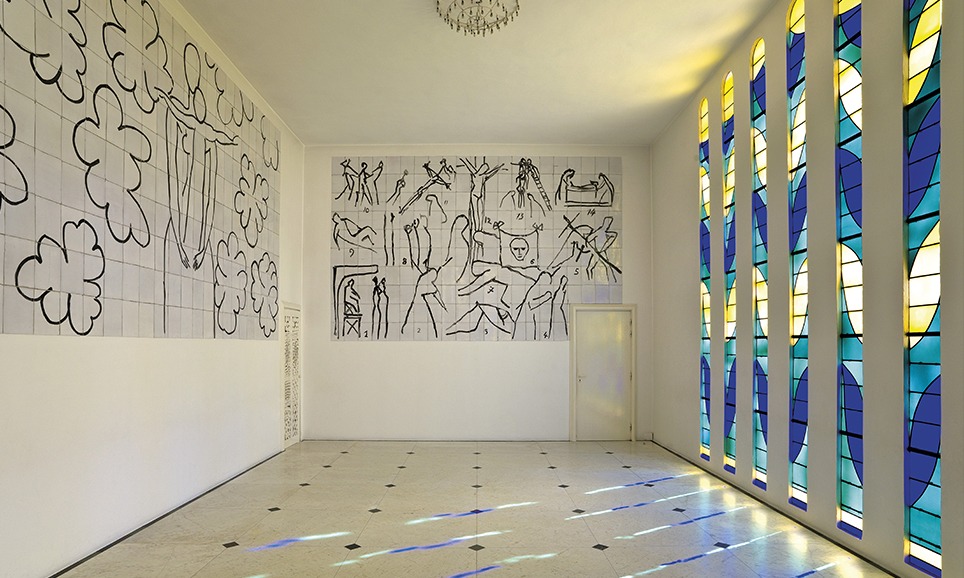Matisse and his chapel in Vence - Willem de Vink
Henri Matisse: Chapelle du Rosaire, Vence, France

Longing for Rest
by Willem de Vink
Henri Matisse considered himself lucky for waking every morning in the Mediterranean light, after he had decided to go and live on the French Riviera. Here he worked in spacious high-ceilinged rooms. He worked in a most focussed manner, ‘like a doctor,’ as his model and assistant, Lydia Delektorskaya, said.
Matisse was often sick. Nevertheless his work radiates joie de vivre. When you step into the Chapelle du Rosaire, also called ‘the Matisse Chapel,’ you feel this joy. Matisse was asked to plan and decorate this building, designed by Auguste Perret (1874-1954), that is in Vence, a few kilometres from Nice. He created the stained-glass windows, murals, priestly garments, the complete interior including chairs, tables, lamps, altar, cross, everything!
Matisse kept it simple, not only because he was already at an advanced age – he was 77 when he started this project. During the course of his life, he had gone through all kinds of artistic phases, from impressionist to almost abstract, and in each he displayed his timeless greatness in form and colour. Now he simplified his style, reducing it to its essence. What he produced could almost be considered childlike, if it were not so spot-on. He wanted his work to radiate rest, first and foremost rest.

And a sense of rest does prevail. Everything in the chapel looks light. The walls are white. The decorative murals consist solely of black lines. They look simple, as if they are produced effortlessly, yet Matisse painted them out of his rich experience. He was also limited because he had to work seated in a wheelchair, his brush attached to a stick. On one of the shiny, tiled walls we see the fourteen stations of the cross brought together into one composition. On another wall a Madonna with Child has been painted in the same line-drawing style, surrounded by clouds. Matisse used just three colours for the stained glass, yellow, green, and blue, so that the light would fall serenely from the windows into the spaces. Peace and stillness were essential for this project. During his whole life Matisse had been searching for rest for his restless soul, for ‘a comfortable armchair’ as he called his art. Finally, that rest could be found here.
The chapel project was started after Matisse had heard that he had cancer. His nurse, Monique Bourgois, entered a Dominican convent as a nun. Here Matisse was offered the possibility for the design of the chapel. Since 1216, the Dominicans have been fulfilling the mission to, as they put it, ‘by means of education, media, science, and art proclaim the gospel of Jesus Christ for the sake of people’s happiness.’ It is wondrous that Matisse could bring his own contribution to this mission at the end of his life. It was to give him the greatest satisfaction.
With their instinct for beauty, artists are able to evoke a longing for a world that is still to come. Matisse did that with his balanced compositions and stunning use of colour. When he could barely stand anymore, he transformed paper cuttings into magnificent collages that evoked a paradisical atmosphere. The chapel in Vence (at which he worked from 1947 until 1952) was his apotheosis, also as far as he himself was concerned, because here he brought together art and faith. He died aged 84 and left the chapel behind as, in his own words, his ‘masterpiece.’
What about our masterpiece? We could create such a chapel for ourselves at home, a space where we can come to rest because all distractions have been banned from it. It is also possible to find this rest in our heart, because we have learned to concentrate ourselves on Jesus’ love wherever we find ourselves. Matisse took the whole of his life to peel off what did not matter. We may discover that in the presence of Jesus everything that does not matter will automatically slide off from us. The rest that he provides is enough.
*******
Read more: Matthew 11:28-30; Matthew 6:25-34; Hebrews 4:10; Psalm 131; Psalm 139.
Henri Matisse: Chapelle du Rosaire, 1947-1952, Vence, France.
Henri Matisse (1869-1954), one of the undisputed masters of 20th century art, was a French artist, known for his use of colour and his fluid and original draughtsmanship. He was a draughtsman, printmaker, and sculptor, but is known primarily as a painter. Matisse is commonly regarded, along with Picasso and Marcel Duchamp, as one of the three artists who helped to define the revolutionary developments in the plastic arts in the opening decades of the 20th century, responsible for significant developments in painting and sculpture. Although he was initially labelled a Fauve (wild beast), by the 1920s he was increasingly hailed as an upholder of the classical tradition in French painting. His mastery of the expressive language of colour and drawing, displayed in a body of work spanning over a half-century, won him recognition as a leading figure in modern art. Source: https://www.henrimatisse.org
Willem de Vink (Utrecht, b. 1957) is a Dutch speaker, writer, and illustrator. His picture story book Jezus Messias (Jesus Messiah) has been published in more than 200 languages. He also wrote the book Dit is liefde, Vincent (This is Love, Vincent). He recently published the book In het hoofd van de maker, Creativiteit, Kunst, Kerk (In the Mind of the Maker: Creativity, Art, Church).
ArtWay Visual Meditation 22 October 2023






